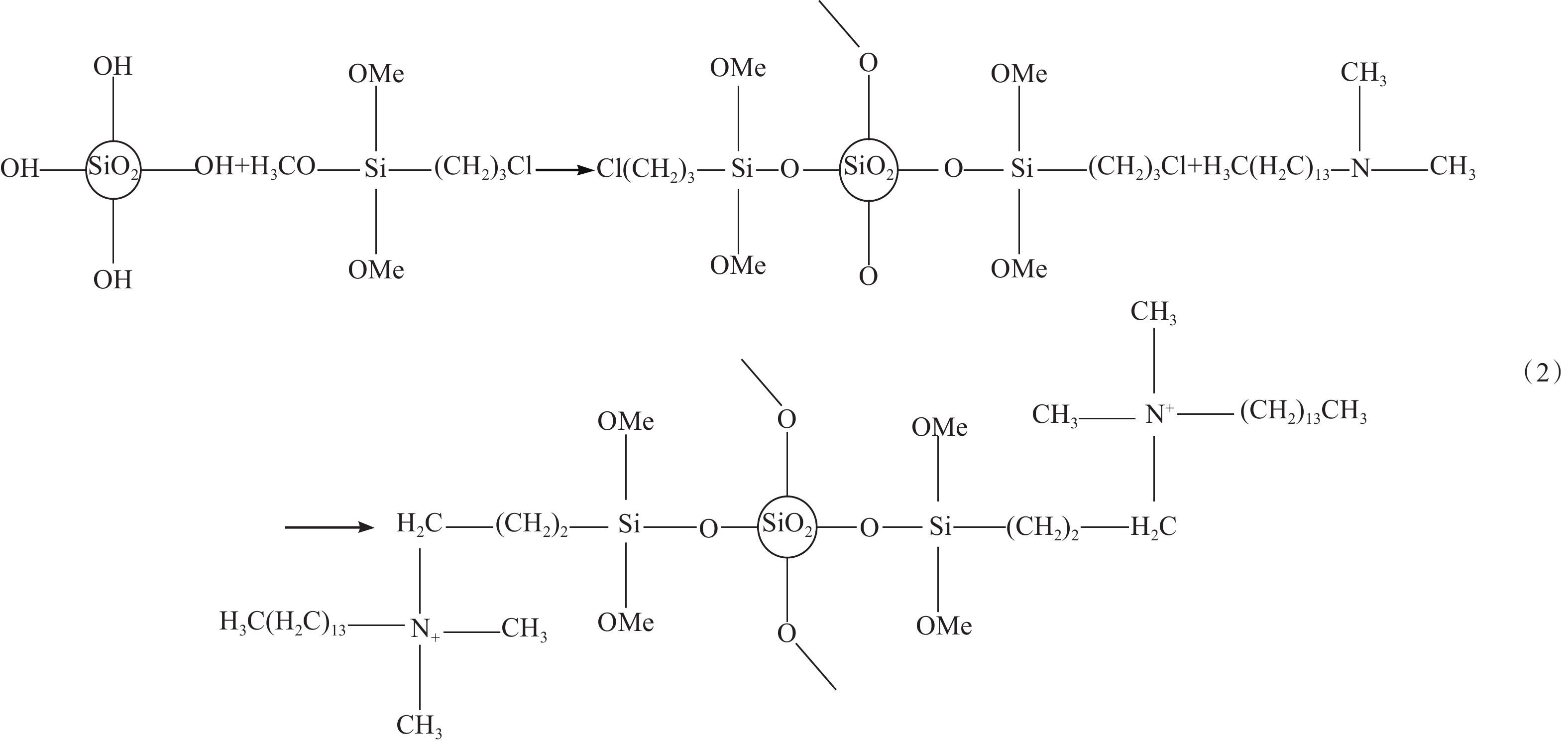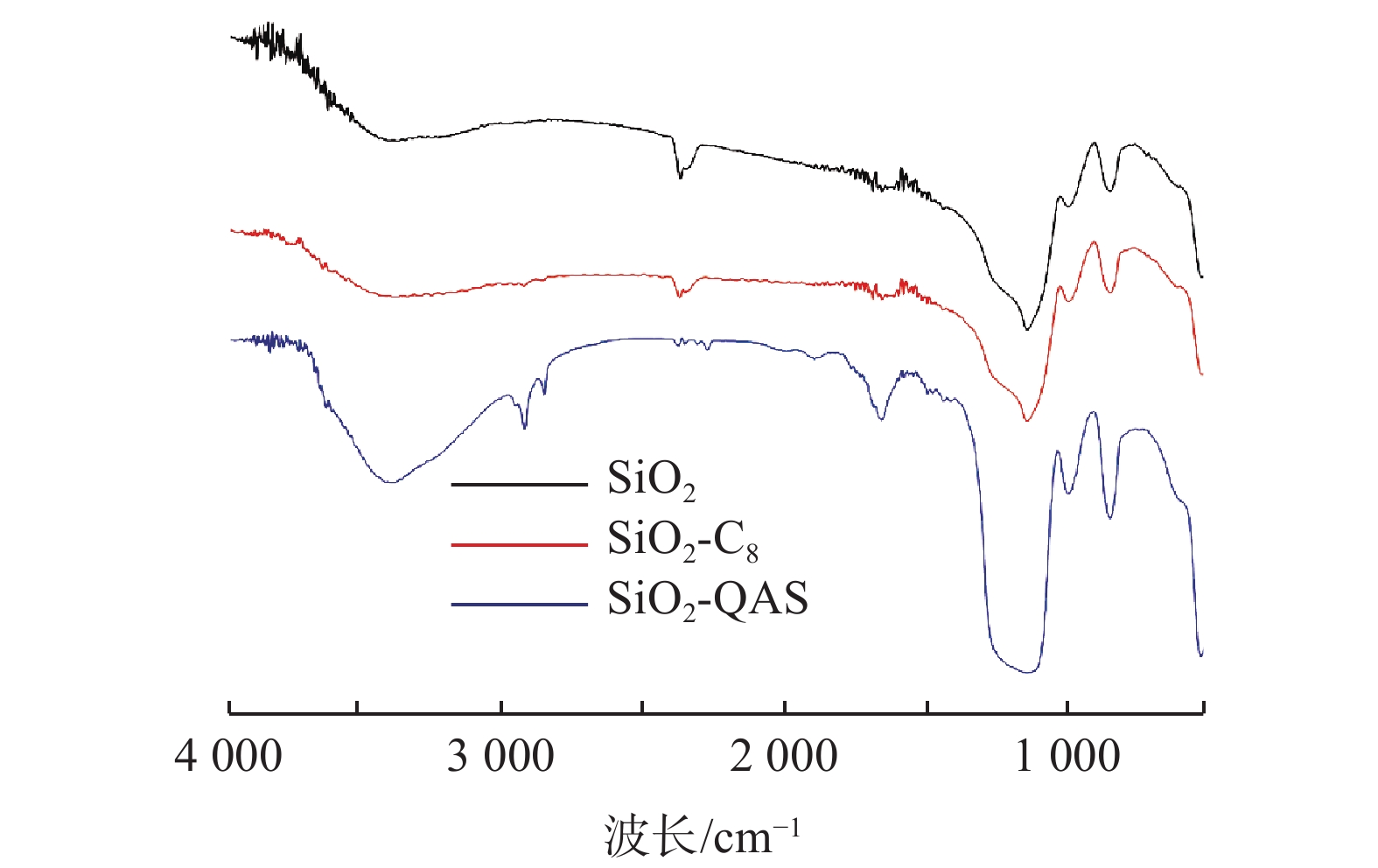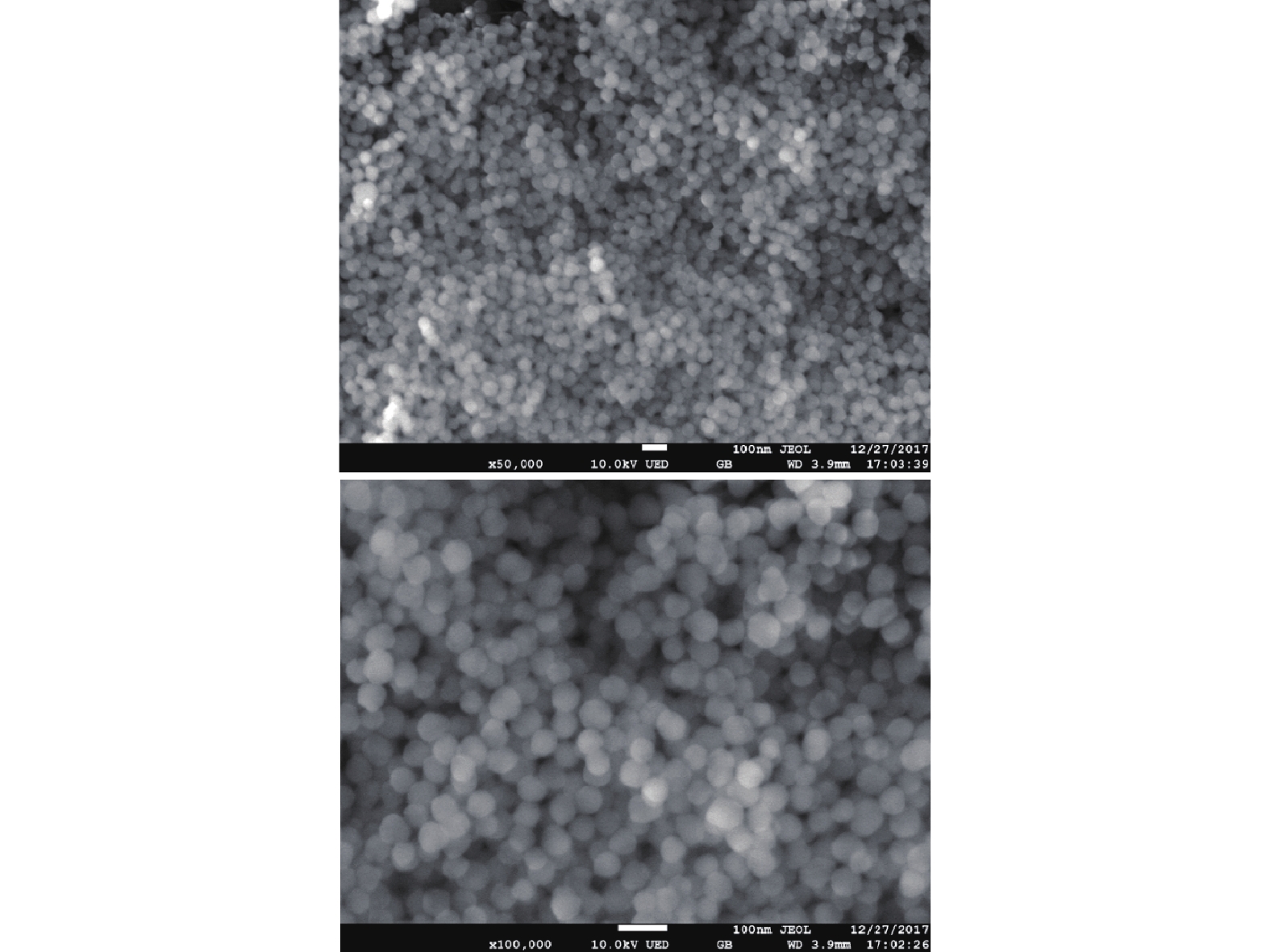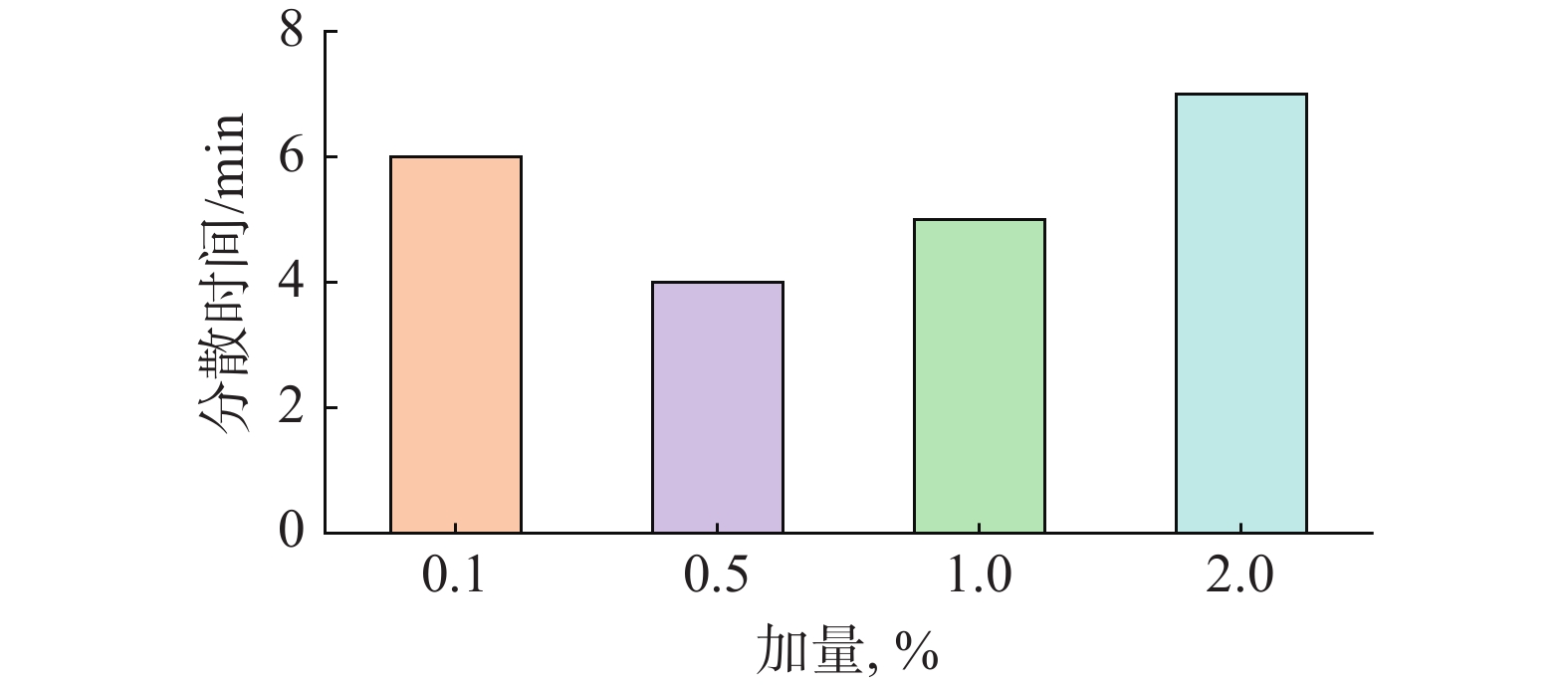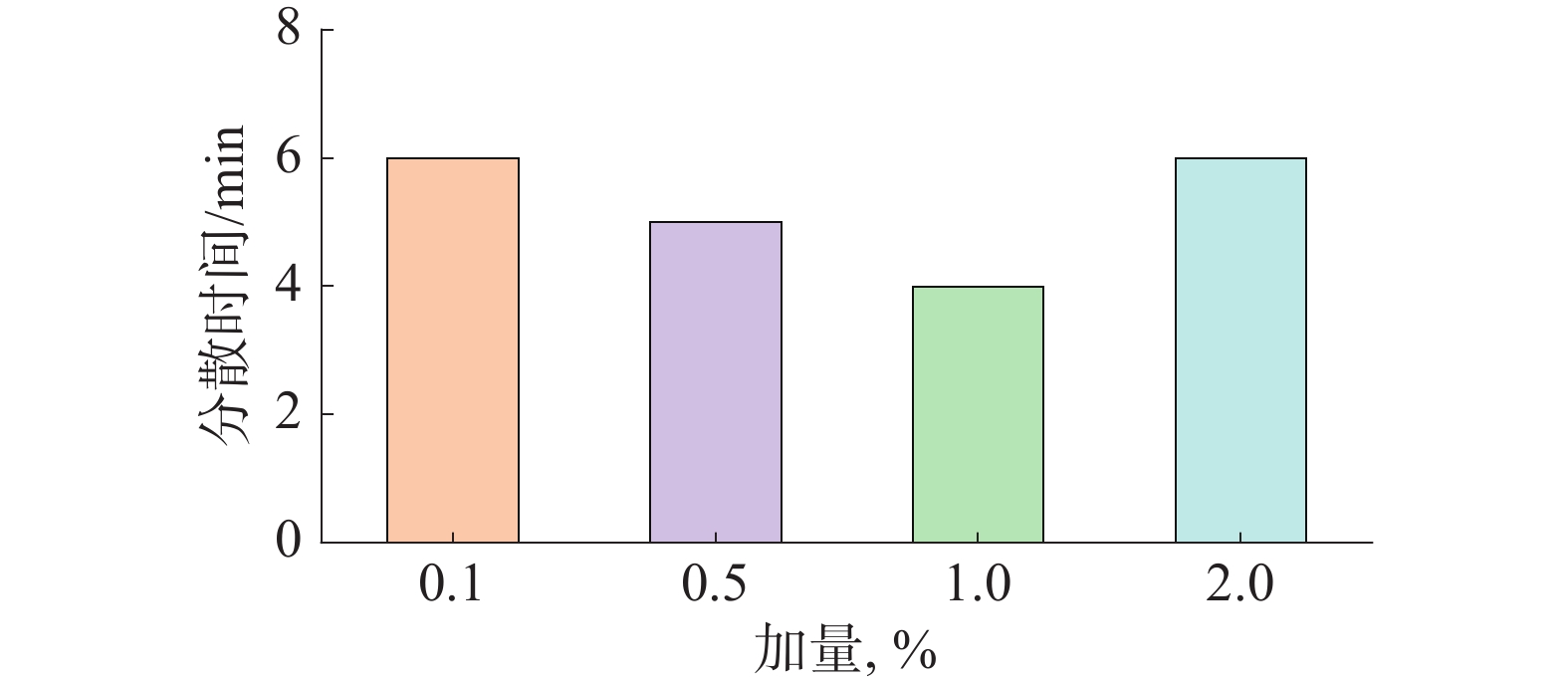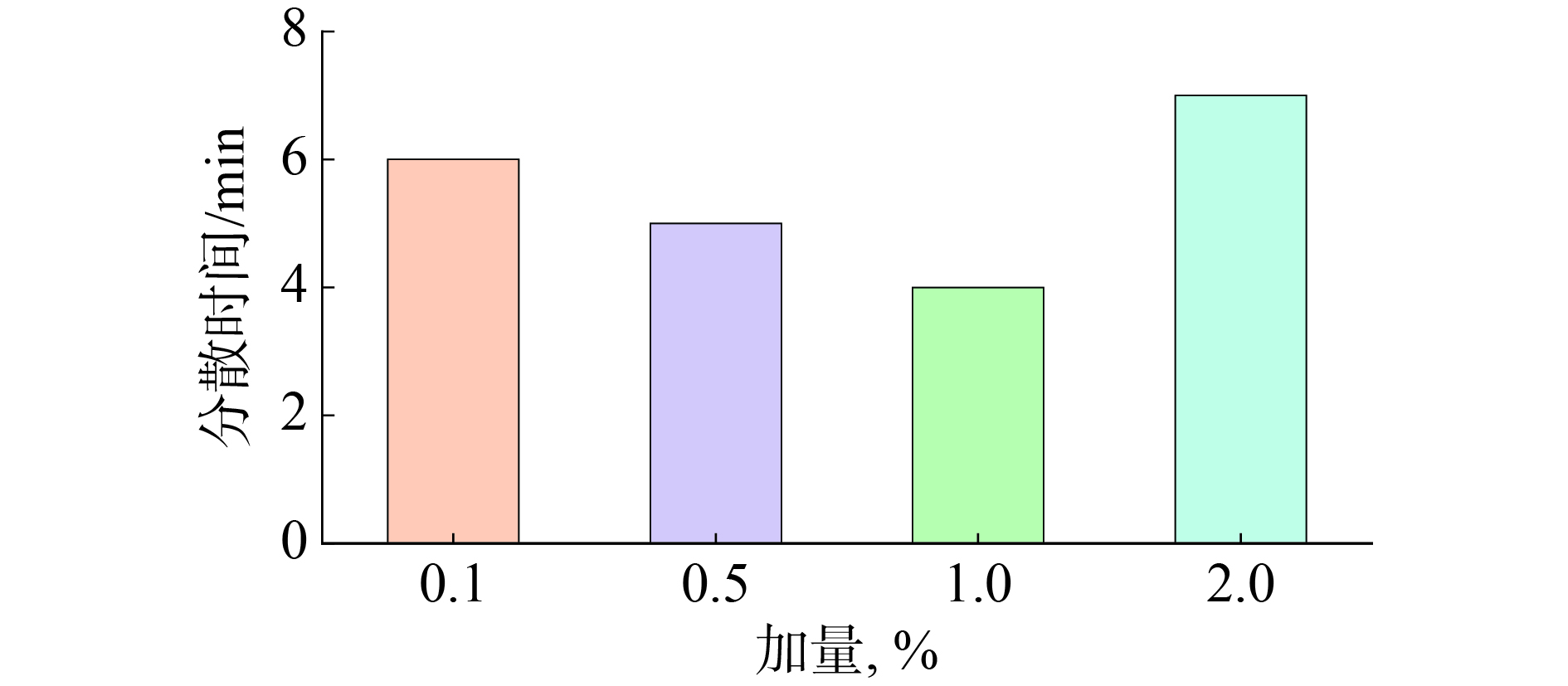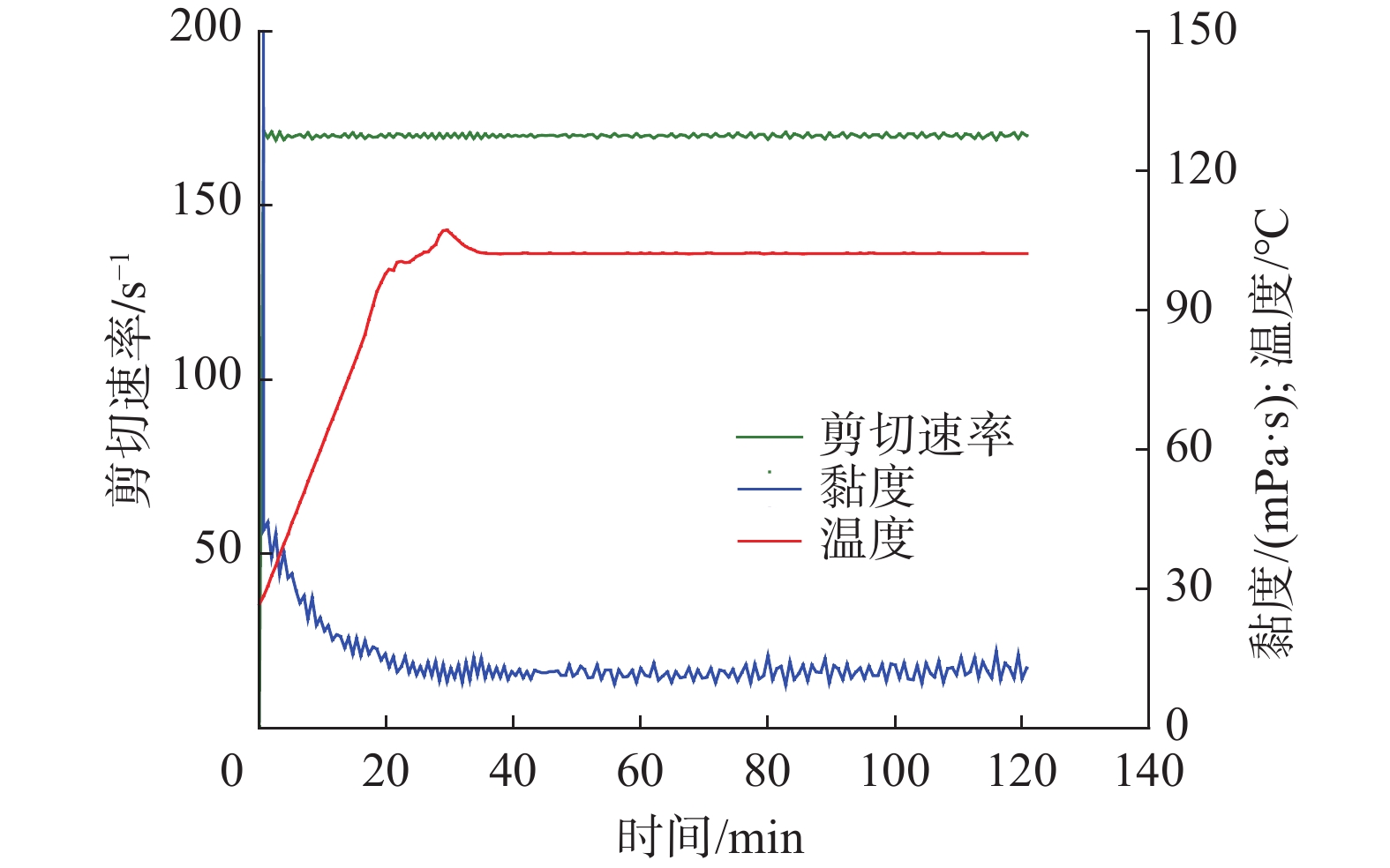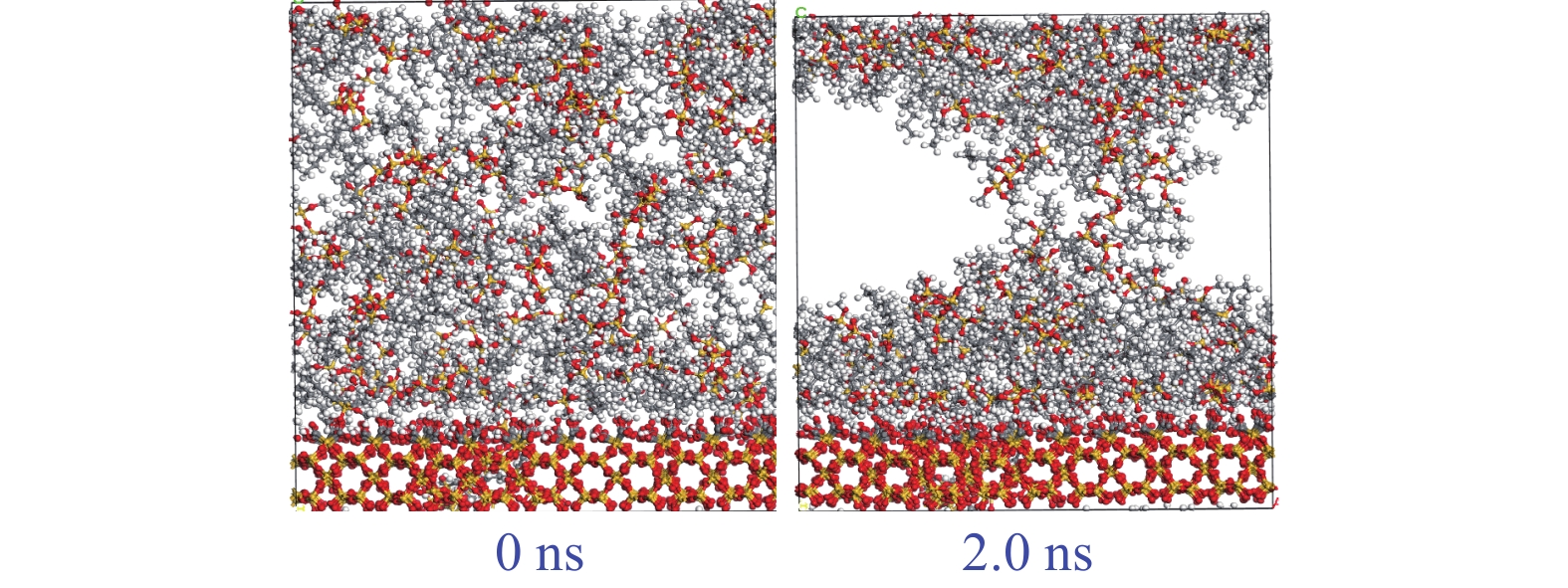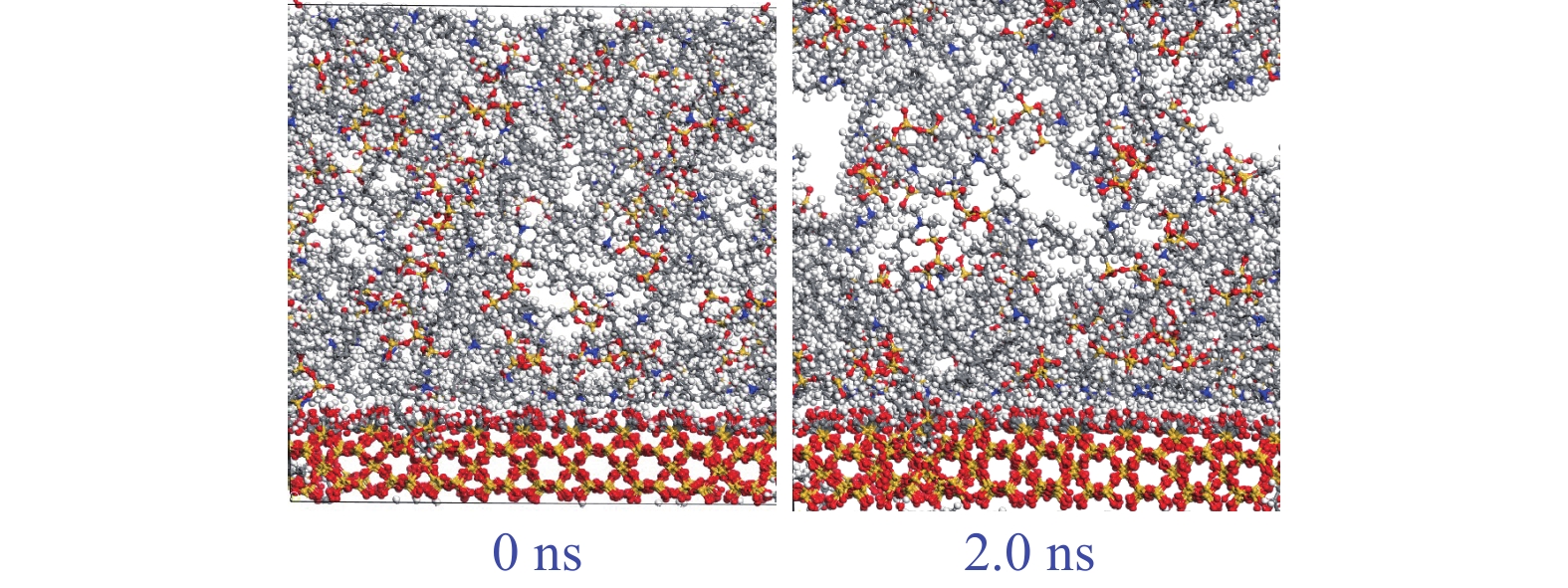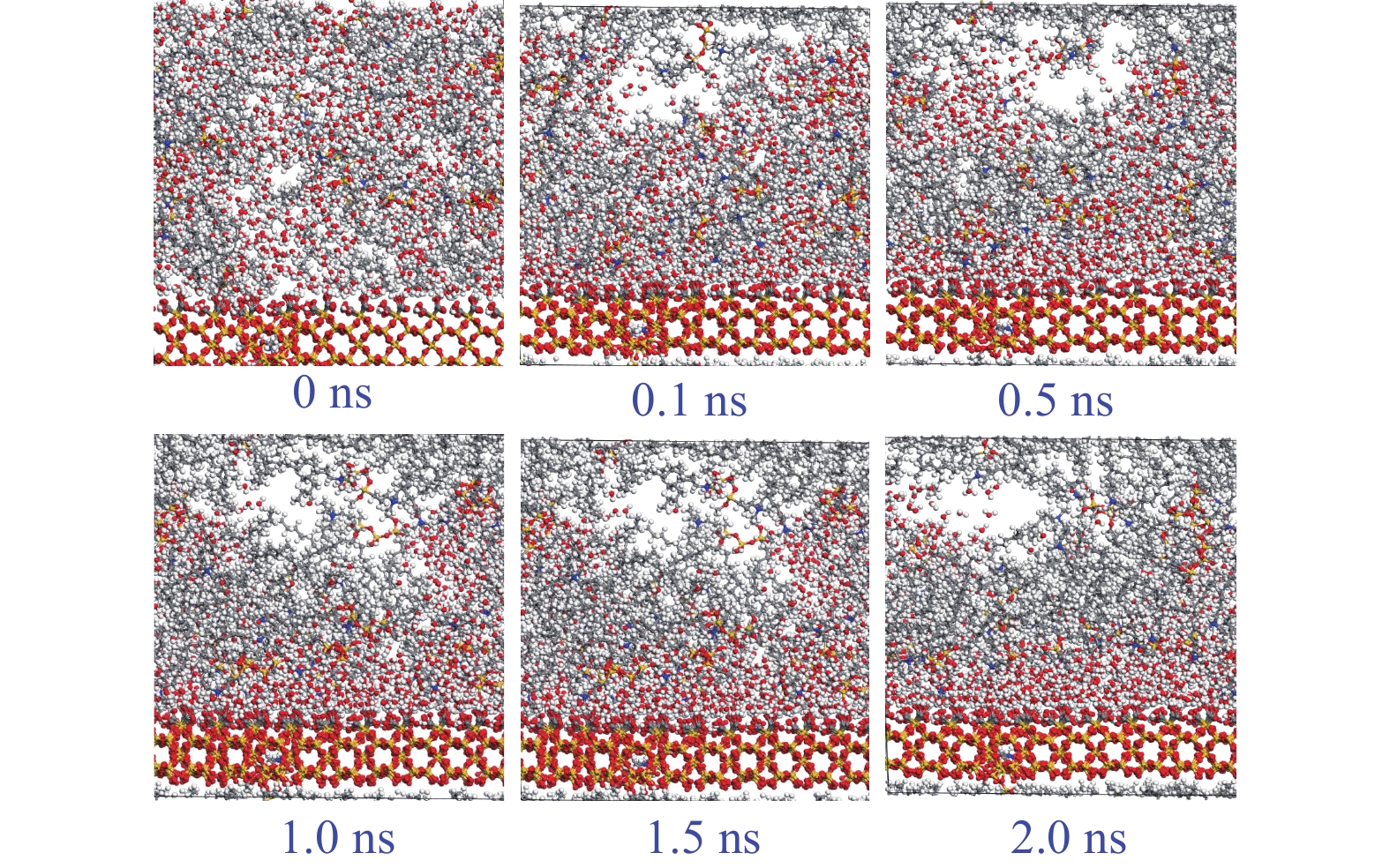Study on Mechanism of the Fracturing Fluid Performance Improvement and Oil Displacement Using Nanomaterials
-
摘要: 为给研发功能性压裂液提供理论依据,在纳米尺度(50 nm)对SiO2进行C8和季铵盐(QAS)修饰,合成了疏水纳米材料SiO2-C8和疏水带电纳米材料SiO2-QAS,评价了SRFP型聚合物清洁压裂液分别加入SiO2,SiO2-C8及SiO2-QAS等3种纳米材料后的配伍性、稳定性及综合性能;利用量化模拟手段,建立了纳米材料在砂岩表面的吸附结构模型及吸附动力学模型,分析了纳米材料在砂岩表面的吸附及油水分离特征。试验及模拟结果表明:SiO2,SiO2-C8及SiO2-QAS等3种纳米材料在压裂液中具有较好的分散稳定性,可有效降低表界面张力,表现出良好的耐温、耐剪切性能;SiO2-C8和SiO2-QAS加入压裂液后有利于砂岩表面油分子被置换出,促进油水分离;SiO2-C8和SiO2–QAS加入压裂液后可有效改善压裂液性能,提高驱油效果,降低压裂液波及范围内的含油饱和度。研究结果可为功能性压裂液发展和研制提供理论依据,为优化致密油、页岩油压裂方案和优选压裂液提供参考。Abstract: To provide a theoretical basis for the development of functional fracturing fluids, SiO2 was modified with C8 and quaternary ammonium salt (QAS) on nanoscale (50 nm). The hydrophobic nanomaterial SiO2-C8 and hydrophobic charged nanomaterial SiO2-QAS were synthesized. The compatibility, stability, and comprehensive performance of the SRFP polymer clean fracturing fluid systems were evaluated as nanomaterials SiO2, SiO2-C8, and SiO2-QAS were added. Quantitative simulation methods were employed to build the adsorption structure models and adsorption kinetics models of the nanomaterials on the sandstone surface. The adsorption and oil-water separation characteristics of nanomaterials on sandstone surfaces were analyzed. The experimental and simulation results show that the three nanomaterials, SiO2, SiO2-C8, and SiO2-QAS, display favorable dispersion stability in fracturing fluids. They can effectively reduce the surface and interfacial tension and demonstrate good temperature and shear resistance. SiO2-C8 and SiO2-QAS nanomaterials are beneficial to the replacement of oil molecules on the sandstone surface and the oil-water separation when they are added into fracturing fluids. The addition of nanomaterials SiO2-C8 and SiO2-QAS can also effectively improve the performance of fracturing fluids, enhance oil displacement, and reduce oil saturation within the spread range of fracturing fluids. The research results can provide a theoretical basis for the development of functional fracturing fluids and a reference for fracturing design optimization and fracturing fluid selection for tight oil and shale oil.
-
-
表 1 低黏清洁压裂液加入纳米材料前后的表面张力
Table 1 Surface tension before and after nanomaterials added to low-viscosity clean fracturing fluids
mN/m 纳米材料加量,% 压裂液 SiO2 SiO2-C8 SiO2-QAS 0.1 33.6 17.7 22.3 28.8 0.5 15.7 20.7 23.0 1.0 13.8 20.2 22.4 2.0 12.5 18.6 24.2 表 2 低黏清洁压裂液加入纳米材料前后的表界面张力
Table 2 Surface and interfacial tension before and after nanomaterials added into low-viscosity clean fracturing fluids
纳米材料 表面张力/(mN·m–1) 界面张力/(mN·m–1) 加入前 加入后 加入前 加入后 SiO2 33.6 15.7 2.858 0.212 SiO2-C8 33.6 20.7 2.858 0.239 SiO2-QAS 33.6 23.0 2.858 0.256 表 3 C6H14、SiO2-C8、SiO2-QAS在α-SiO2(010)面的吸附能
Table 3 Adsorption energy of C6H14, SiO2-C8 and SiO2-QAS molecules on the α-SiO2(010) surface
M Ead(SiO2-M)/eV Et(SiO2-M)/eV Et(SiO2)/eV Et(M)/eV C6H14 –1 722 287.31 –6 388.85 –1 715 896.91 –1.54 SiO2-C8 –1 777 032.99 –61 132.64 –1 715 896.91 –3.44 SiO2-QAS –1 803 366.81 –87 460.07 –1 715 896.91 –9.83 -
[1] 夏宏泉,梁景瑞,文晓峰. 基于CQ指标的长庆油田长6—长8段致密油储层划分标准研究[J]. 石油钻探技术,2020,48(3):114–119. XIA Hongquan, LIANG Jingrui, WEN Xiaofeng. The standard division of tight oil reservoirs in Chang 6-8 Members of Changqing Oilfield based on CQ index[J]. Petroleum Drilling Techniques, 2020, 48(3): 114–119.
[2] 丁士东,赵向阳. 中国石化重点探区钻井完井技术新进展与发展建议[J]. 石油钻探技术,2020,48(4):11–20. DING Shidong, ZHAO Xiangyang. New progress and development suggestions for drilling and completion technologies in Sinopec key exploration areas[J]. Petroleum Drilling Techniques, 2020, 48(4): 11–20.
[3] 王晓雯. 致密油藏储层敏感性评价及主控因素研究[J]. 特种油气藏,2021,28(1):103–110. WANG Xiaowen. Study on reservoir sensitivity evaluation and key control factors of tight oil reservoirs[J]. Special Oil & Gas Reservoirs, 2021, 28(1): 103–110.
[4] 孙金声,许成元,康毅力,等. 致密/页岩油气储层损害机理与保护技术研究进展及发展建议[J]. 石油钻探技术,2020,48(4):1–10. SUN Jinsheng, XU Chengyuan, KANG Yili, et al. Research progress and development recommendations covering damage mechanisms and protection technologies for tight/shale oil and gas reservoirs[J]. Petroleum Drilling Techniques, 2020, 48(4): 1–10.
[5] 崔月明,史海民,张清. 吉林油田致密油水平井优快钻井完井技术[J]. 石油钻探技术,2021,49(2):9–13. CUI Yueming, SHI Haimin, ZHANG Qing. Optimized drilling and completion technology for horizontal wells in tight oil reservoirs in the Jilin Oilfield[J]. Petroleum Drilling Techniques, 2021, 49(2): 9–13.
[6] 巩联浩,刘继梓,武兴,等. 裂缝性致密油藏二氧化炭吞吐基质–裂缝间流体渗流特征研究[J]. 特种油气藏,2021,28(1):118–124. GONG Lianhao, LIU Jizi, WU Xing, et al. Study on seepage characteristics of fluid between matrix and fracture in CO2 huff-puff process in fractured tight reservoirs[J]. Special Oil & Gas Reservoirs, 2021, 28(1): 118–124.
[7] 王彦玲,王坤,金家锋,等. 纳米材料在压裂液体系中的应用进展[J]. 精细石油化工,2016,33(6):63–67. doi: 10.3969/j.issn.1003-9384.2016.06.015 WANG Yanling, WANG Kun, JIN Jiafeng, et al. The application of nanometer material in fracturing fluid system[J]. Speciality Petrochemicals, 2016, 33(6): 63–67. doi: 10.3969/j.issn.1003-9384.2016.06.015
[8] 韦青,李治平,白瑞婷,等. 微观孔隙结构对致密砂岩渗吸影响的试验研究[J]. 石油钻探技术,2016,44(5):109–116. WEI Qing, LI Zhiping, BAI Ruiting, et al. An experimental study on the effect of microscopic pore structure on spontaneous imbibition tight sandstone[J]. Petroleum rilling Techniques, 2016, 44(5): 109–116.
[9] 郭建设,周福建,胡晓玲,等. 三塘湖盆地致密油水平井增能压裂力学机理[J]. 断块油气田,2021,28(1):57–62. doi: 10.3969/J.ISSN.1000-3754.2013.05.020 GUO Jianshe, ZHOU Fujian, HU Xiaoling, et al. Mechanical mechanism of horizontal well energized fracturing of tight oil in Santanghu Basin[J]. Fault-Block Oil & Gas Field, 2021, 28(1): 57–62. doi: 10.3969/J.ISSN.1000-3754.2013.05.020
[10] 白晓虎,齐银,何善斌,等. 致密储层水平井压裂–补能–驱油一体化重复改造技术[J]. 断块油气田,2021,28(1):63–67. BAI Xiaohu, QI Yin, HE Shanbin, et al. Integrated re-stimulating technology of fracturing-replenishment-displacement of horizontal wells in tight reservoirs[J]. Fault-Block Oil & Gas Field, 2021, 28(1): 63–67.
[11] 彭振,王中华,何焕杰,等. 纳米材料在油田化学中的应用[J]. 精细石油化工进展,2011,12(7):8–12. doi: 10.3969/j.issn.1009-8348.2011.07.003 PENG Zhen, WANG Zhonghua, HE Huanjie, et al. Application of nanometer materials in oilfield chemistry[J]. Advances in Fine Petrochemicals, 2011, 12(7): 8–12. doi: 10.3969/j.issn.1009-8348.2011.07.003
[12] 侯吉瑞,闻宇晨,屈鸣,等. 纳米材料提高油气采收率技术研究及应用[J]. 特种油气藏,2020,27(6):47–53. HOU Jirui, WEN Yuchen, QU Ming, et al. Research and application of nano-materials to enhance oil and gas recovery technolo-gy[J]. Special Oil & Gas Reservoirs, 2020, 27(6): 47–53.
[13] 蒋莉,袁丽,郑清国. 纳米膨润土复合体的研究与应用[J]. 石油钻探技术,2009,37(3):57–60. JIANG Li, YUAN Li, ZHENG Qingguo. Researches and application of nanometer bentonite complex[J]. Petroleum Drilling Techniques, 2009, 37(3): 57–60.
[14] 褚奇,孔勇,杨帆,等. 多苯基芳基硅烷偶联剂改性纳米SiO2封堵剂[J]. 断块油气田,2017,24(2):281–284. CHU Qi, KONG Yong, YANG Fan, et al. Nano-silica dioxide plugging agent modified by polyphenyl aryl silanes coupling agent[J]. Fault-Block Oil & Gas Field, 2017, 24(2): 281–284.
[15] 李强,李志勇,张浩东,等. 响应面法优化纳米材料稳定的泡沫钻井液[J]. 钻井液与完井液,2020,37(1):23–30. LI Qiang, LI Zhiyong, ZHANG Haodong, et al. Study on foam drilling fluid stabilized with nanometerials optimized with RSM[J]. Drilling Fluid & Completion Fluid, 2020, 37(1): 23–30.
[16] 任保友,蒲晓林,曹成,等. 纳米钻井液提高地层承压能力实验[J]. 石油钻采工艺,2018,40(2):179–184. REN Baoyou, PU Xiaolin, CAO Cheng, et al. Experimental study on improving the formation pressure-bearing capacity by using nano-drilling fluid[J]. Oil Drilling & Production Technology, 2018, 40(2): 179–184.
[17] 辛迎春. 纳米SiO2 改性稠油高效破乳剂的研制及应用[J]. 石油钻探技术,2008,35(5):75–77. XIN Yingchun. Research and application of modified nano-sized silica demulsifier for heavy oil[J]. Petroleum Drilling Techniques, 2008, 35(5): 75–77.
[18] 王伟吉,邱正松,钟汉毅,等. 钻井液用新型纳米润滑剂SD-NR的制备及特性[J]. 断块油气田,2016,23(1):113–116. WANG Weiji, QIU Zhengsong, ZHONG Hanyi, et al. reparation and properties of nanoparticle-based lubricant SD-NR for drilling fluids[J]. Fault-Block Oil & Gas Field, 2016, 23(1): 113–116.
[19] 雷天猛,王秀军,王姗姗,等. 纳米二氧化硅改性聚合物的油藏适用性评价与微观驱油效果研究[J]. 石油钻探技术,2021,49(1):107–112. LEI Tianmeng, WANG Xiujun, WANG Shanshan, et al. Research on reservoir applicability evaluation and micro oil flooding effect of a nano-Silica modified polymer[J]. Petroleum Drilling Techniques, 2021, 49(1): 107–112.
[20] 王胜,谌强,袁学武,等. 适用于低温地层的纳米复合水泥浆体系研究[J]. 石油钻探技术,2021,49(6):73–80. WANG Sheng, CHEN Qiang, YUAN Xuewu, et al. Research on a nano-composite cement slurry system suitable for low-temperature formations[J]. Petroleum Drilling Techniques, 2021, 49(6): 73–80.
[21] HUANG T, CREWS J B, AGRAWAL G. Nanoparticle pseudocrosslinked micellar fluids: optimal solution for fluid-loss control with internal breaking[R]. SPE 128067, 2010.
[22] CREWS J B, HUANG Tianping. Performance enhancements of viscoelastic surfactant stimulation fluids with nanoparticles[R]. SPE 113533, 2008.
[23] CREWS J B, HUANG Tianping, WOOD W R. The future of fracturing-fluid technology and rates of hydrocarbon recovery[R]. SPE 115475, 2008.
[24] CREWS J B, GOMAA A M. Nanoparticle-associated surfactant micellar fluids: an alternative to crosslinked polymer systems[R]. SPE 157055, 2012.
[25] GURLUK M R, NASR-EL-DIN H A, CREWS J B. Enhancing the performance of viscoelastic surfactant fluids using nanoparticles[R]. SPE 164900, 2013.
[26] 杨兆中,朱静怡,李小刚,等. 含纳米颗粒的黏弹性表面活性剂泡沫压裂液性能[J]. 科学技术与工程,2018,18(10):42–47. doi: 10.3969/j.issn.1671-1815.2018.10.007 YANG Zhaozhong, ZHU Jingyi, LI Xiaogang, et al. The performance of viscoelastic foamed fracturing fluids with nanoparticles[J]. Science Technology and Engineering, 2018, 18(10): 42–47. doi: 10.3969/j.issn.1671-1815.2018.10.007
[27] 段瑶瑶,杨战伟,杨江,等. 一种新型纳米复合清洁压裂液的研究与应用[J]. 科学技术与工程,2016,16(30):68–72. doi: 10.3969/j.issn.1671-1815.2016.30.011 DUAN Yaoyao, YANG Zhanwei, YANG Jiang, et al. Research and application of a new nanocomposite cleaning fracturing fluid[J]. Science Technology and Engineering, 2016, 16(30): 68–72. doi: 10.3969/j.issn.1671-1815.2016.30.011
[28] 杜涛,姚奕明,蒋廷学,等. 新型疏水缔合聚合物压裂液综合性能评价[J]. 精细石油化工,2014,31(3):72–76. doi: 10.3969/j.issn.1003-9384.2014.03.017 DU Tao, YAO Yiming, JIANG Tingxue, et al. Study on properties of new hydrophobic associating polymer fracturing fluid[J]. Speciality Petrochemicals, 2014, 31(3): 72–76. doi: 10.3969/j.issn.1003-9384.2014.03.017
[29] 杜涛,姚奕明,蒋廷学,等. 新型疏水缔合聚合物压裂液性能研究与现场应用[J]. 精细石油化工,2015,32(2):20–24. doi: 10.3969/j.issn.1003-9384.2015.02.005 DU Tao, YAO Yiming, JIANG Tingxue, et al. Properties and field application of a novel hydrophobic associating polymer fracturing fluid[J]. Speciality Petrochemicals, 2015, 32(2): 20–24. doi: 10.3969/j.issn.1003-9384.2015.02.005
[30] 潘意坤,郭平,罗强,等. 致密气在α-SiO2(010)面吸附的第一性原理研究[J]. 原子与分子物理学报,2018,35(3):415–421. doi: 10.3969/j.issn.1000-0364.2018.03.009 PAN Yikun, GUO Ping, LUO Qiang, et al. First-principles calculation of adsorption for tight gas on α-SiO2(010) surface[J]. Journal of Atomic and Molecular Physics, 2018, 35(3): 415–421. doi: 10.3969/j.issn.1000-0364.2018.03.009




 下载:
下载:

